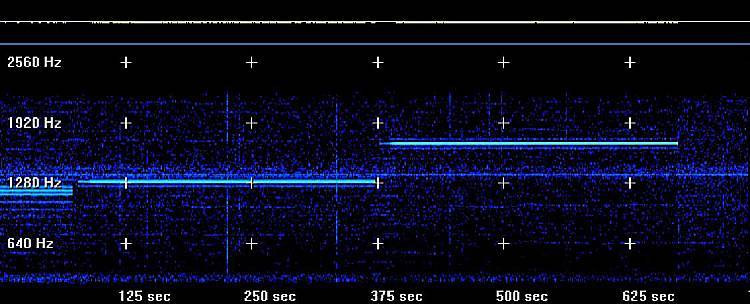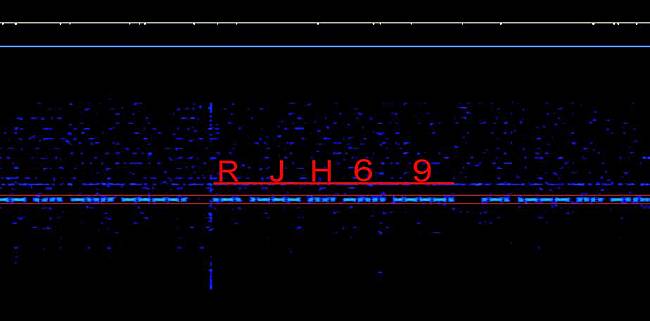



|
Freq.
in kHz
|
Time
UTC
|
Emission
|
Remarks
|
|
25.00
|
XX:00
XX:30 XX:??
|
Tune
up
|
Adjust
phase
|
|
|
01
31
|
A0
|
|
|
|
06
36
|
A1
|
Callsign,
ID using morse code
|
|
|
07
37
|
A0
|
|
|
|
10
40
|
A9
|
40
Hz modulation, double sideband – full carrier
|
|
|
13
43
|
A9
|
10
pps time code ( 0.1,1,10,60 sec markers )
|
|
|
22
52
|
A9
|
40
Hz modulation, double sideband – full carrier
|
|
|
25
55
|
Turn
off
|
|
|
25.10
|
25
55
|
Tune
up
|
Adjust
phase
|
|
|
26
56
|
A0
|
|
|
|
30
XY:00
|
Turn
off
|
|
|
25.50
|
30
00
|
Tune
up
|
Adjust
phase
|
|
|
31
01
|
A0
|
|
|
|
35
05
|
Turn
off
|
|
|
23.00
|
35
05
|
Tune
up
|
Adjust
phase
|
|
|
36
06
|
A0
|
|
|
|
41
11
|
Turn
off
|
|
|
20.50
|
41
11
|
Tune
up
|
Adjust
phase
|
|
|
42
12
|
A0
|
|
|
|
XX:47
XY:17 XX:??
|
Turn
off
|
|
|
|
|
|
XX
= transmission start hour
|
|
|
|
|
XY
= transmission start hour + 1
|
|
Frequency
in Khz
|
Time
UTC
|
Emission
|
Remarks
|
|
25.00
|
11:00
|
Tune
up
|
Adjust
phase
|
|
|
01
|
A0
|
|
|
|
06
|
A1
|
Callsign,
ID using morse code
|
|
|
07
|
A0
|
|
|
|
09
|
A9
|
40
Hz modulation, double sideband – full carrier
|
|
|
11
|
A9
|
10
pps time code ( 0.1,1,10,60 sec markers )
|
|
|
20
|
Turn
off
|
|
|
25.10
|
20
|
Tune
up
|
Adjust
phase
|
|
|
22
|
A0
|
|
|
|
23
|
Turn
off
|
|
|
25.50
|
23
|
Tune
up
|
Adjust
phase
|
|
|
24
|
A0
|
|
|
|
26
|
Turn
off
|
|
|
23.0
|
26
|
Tune
up
|
Adjust
phase
|
|
|
27
|
A0
|
|
|
|
31
|
Turn
off
|
|
|
20.50
|
31
|
Tune
up
|
Adjust
phase
|
|
|
32
|
A0
|
|
|
|
36
|
F1B
|
FSK
300 Hz shift
|
|
|
11:40
|
Turn
off
|
|


| Station\time |
00
|
01
|
02
|
03
|
04
|
05
|
06
|
07
|
08
|
09
|
10
|
11
|
12
|
13
|
14
|
15
|
16
|
17
|
18
|
19
|
20
|
21
|
22
|
23
|
|
RJH63
|
|
|
|
|
|
|
|
|
|
|
|
X
|
|
|
|
|
|
|
|
|
|
|
|
|
|
RJH66
|
|
|
|
|
?
|
|
|
|
|
|
X
|
|
|
|
|
|
|
|
|
|
?
|
|
|
|
|
RJH69
|
|
|
|
|
|
|
|
X
|
|
|
|
|
|
?
|
|
|
|
|
|
|
|
|
|
|
|
RJH77
|
|
|
|
?
|
|
|
|
|
|
X
|
|
|
|
|
|
|
|
|
|
|
|
|
|
|
|
RJH99
|
|
|
|
|
|
X
|
|
|
|
|
|
|
|
|
|
|
|
|
|
?
|
|
|
|
|
|
RAB99
|
|
|
|
?
|
|
|
|
|
|
?
|
|
|
|
|
|
?
|
|
|
|
|
|
|
|
|


|
STATION
ID
|
LOCATION
|
COORDINATES
|
|
RJH63
|
Krasnodar,
Russia
|
44N36
39E34
|
|
RJH66
ex USB2
|
Bishkek,
Kirgyztan
|
43N04
73E39
|
|
RJH69
ex UNW3
|
Molodechno,
Belarus
|
54N26
26E48
|
|
RJH77
ex UPD8
|
Arkhangelsk,
Russia
|
64N24
41E32
|
|
RJH99
ex UTR3
|
Nizhny
Novgorod, Russia
|
56N11
43E58
|
|
RAB99
ex UQC3
|
Khabarovsk,
Russia
|
48N30
134E52
|